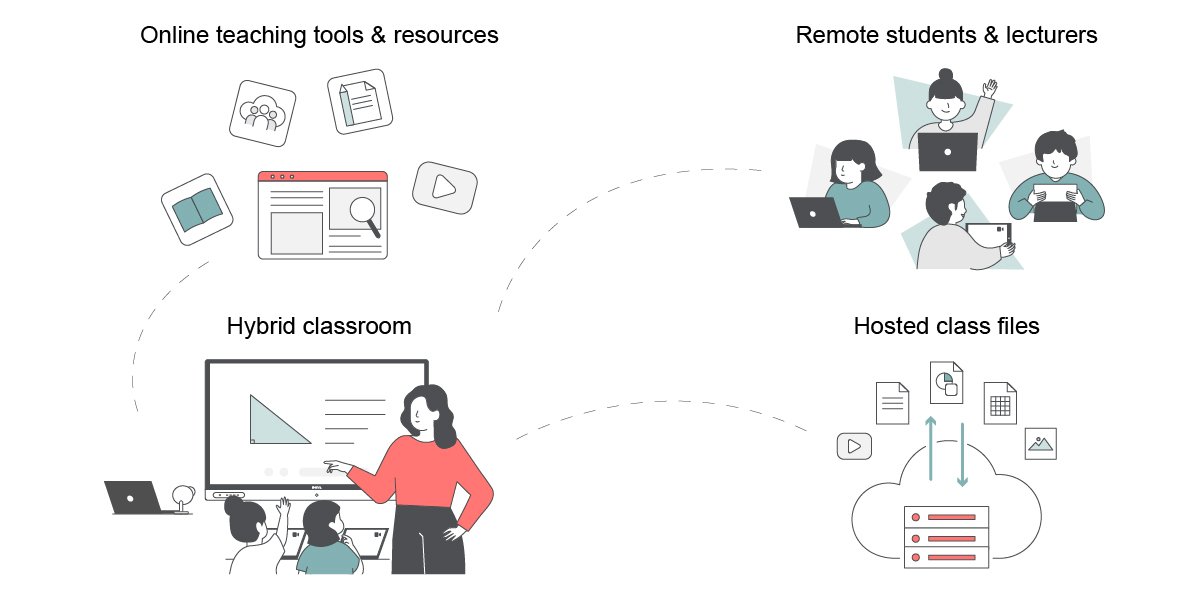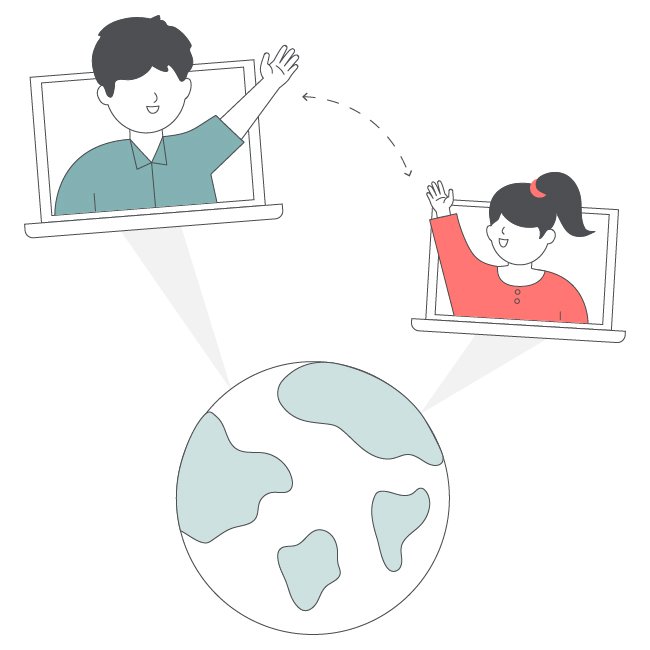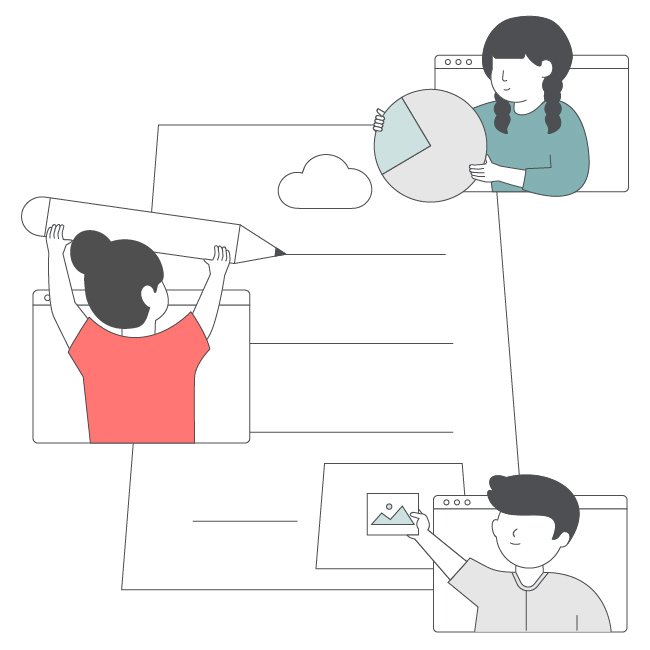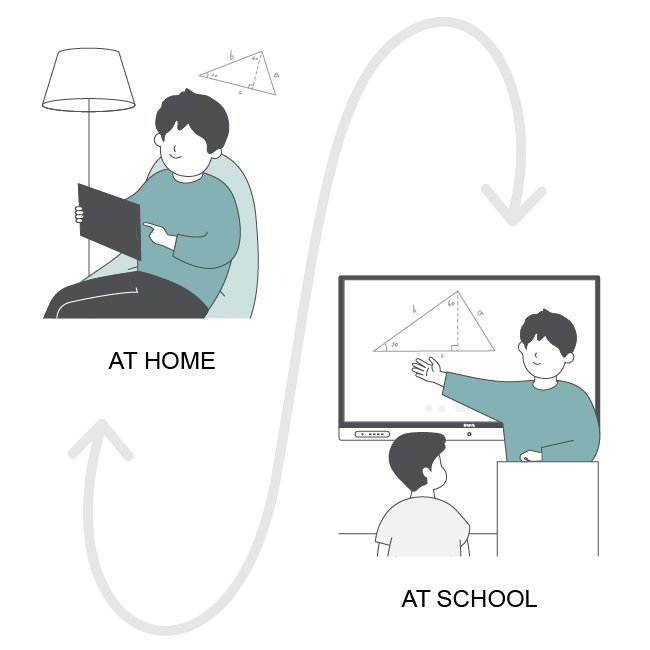- BenQ
- 2021-11-17
Schools are either already on the cloud or heading there very soon.
The way in-person classes took a hit during the pandemic—affecting over a billion learners worldwide1—has underscored one truth that many in the education and technology sectors have been advocating for years: that the move to the cloud is crucial and inevitable.
For long-time educators, thinking about something as abstract as the cloud may be a lot to take in, but using it for schooling is actually quite straightforward. Whether they’re aware of it or not, teachers who use their smartphones on a regular basis are already active cloud users. They just have to learn how to apply what they normally do on their gadgets to the way they conduct their classes.
But what is the cloud anyway?
In the simplest terms, the cloud is a bunch of servers that are accessible via the internet.2 Organisations utilize the cloud to host websites and apps that most of us use daily. We take advantage of the cloud every time we listen to music on streaming sites, send out emails, or like posts on social media. In education, the cloud enters the picture when we share lesson content through Google Classroom or Microsoft Teams, write instructions on cloud whiteboards, or hop onto a video call to reach home-based students when classrooms are inaccessible.
How schools can utilise the cloud for blended in-person and hybrid classes

Education systems across multiple countries have already shifted to cloud services to virtually extend their classrooms to remote students.3 It’s a trend best reflected by the steady increase of active cloud service users in schools. Zoom, for example, reported a record-breaking increase in their number of monthly users after extending their enterprise-focused video conferencing services to the education sector.4 Similarly, both Google and Microsoft noted how their daily active user bases grew significantly throughout the pandemic, and have continued to do so since schools returned to face-to-face teaching. Educational institutions realised afresh that the cloud tools that worked for remote teaching & learning were effective in a more traditional setting.
Cloud adoption by numbers (Google and Microsoft)
By 2025, Gartner forecasts that as much as 85% of organisations worldwide, including schools, will adopt a “cloud-first” approach. This means that cloud infrastructure and applications will be more heavily integrated with new systems or be used to enhance existing ones.11 Hybrid and remote modes of learning will be mainstays in education. Analysts recommend that CIOs, particularly for K-12 schools, must make it a goal to invest in bolstering their existing infrastructure and supply their students with the necessary devices to better facilitate these cloud-dependent learning setups.12
Initial Doubts vs. Long-Term Benefits
Despite the increasing prevalence of the cloud in schools, there has still been some pushback from educators. Much of their hesitation stems from preconceived notions of how cloud-based technologies complicate teaching.
In a study published in 2013, researchers noted that although teachers have had experience using cloud-based educational tools for their lessons, the general consensus was that these were more of a nice-to-have rather than a necessity.13 In a separate study conducted by the University of Bristol, a number of instructors believed that, compared to regular rote instruction, using apps and gadgets made their teaching less effective.14
Many educators have expressed that the introduction of new technologies in schools has doubled their work.15 Not only do they have to quickly figure out how to incorporate these tools into their lessons, but they may also be tasked with helping out students who are struggling with using unfamiliar devices and programs.16
Although these collective sentiments are valid, much of these apprehensions are temporary. Research has shown that lack of knowledge is actually one of the biggest factors why teachers are either averse to new educational technologies or unable to use them to their full potential.17 Up to 70% of the teachers who participated in the research were able to find creative ways to integrate EdTech into their classes after sufficient training.
Several universities recognise the impact of the cloud and EdTech in teaching, so much so that they have made it a point to incorporate online and hybrid teaching methodologies in the curriculum of their education graduate programmes. Education undergraduates are now being trained on how to use available technologies such as cloud apps, video conferencing systems, and interactive displays for classes.18 For tenured educators, adapting their teaching styles to accommodate the cloud may seem like a bothersome task, but as the pandemic has clearly demonstrated, the need to adapt is necessary.19
Despite initial doubts, these long-term benefits of cloud adoption in schools make the investment well worth it:

Using the cloud significantly improves a school’s operational resilience. In the event of a temporary school closure, its administration can quickly shift to remote or hybrid modes of instruction, ensuring that student progress is left uninterrupted.
Since cloud-based learning management systems and online educational resources are not physically confined to the campus, teachers and students never lose access to lesson materials. They can easily download course content on their school-issued devices and join classes via video conferencing.

Using the cloud opens up classrooms, granting schools more virtual space to accommodate a broader spectrum of students and teachers. Leveraging the power of video conferencing not only allows educational institutions to offer classes to off-site learners, but it also opens up opportunities for them to invite remote instructors and industry experts who can address multiple groups of students at the same time.

Cloud whiteboards and other online productivity tools allow students to exchange ideas and work together on shared projects in real time. In completely remote learning setups where students rarely get to see their classmates in person, these tools give them an avenue to interact with each other, allowing them to socialise with their peers as they learn together.

Migrating lesson content to the cloud also makes it easy for schools to adopt the flipped classroom setup—an effective active learning style that is known to equip graduates with 21st century skills.
In this scenario, students are encouraged to self-study on their own time using the cloud-based content the school provides them. Teachers then become facilitators who use classroom sessions to host activities that help students synthesise ideas and discover practical applications of the concepts they’ve learned.20

Using the cloud for education also helps both students and their teachers become better accustomed to technology. This isn’t limited to their knowledge of how to operate hardware and software, it also extends to their creativity (how they use these tools as a medium to communicate) and etiquette (how they should behave in shared spaces online). It trains them to become more well-rounded users of technology.
No matter which stage your school is at in terms of cloud adoption, BenQ can support you. Whether you’re using cloud-based platforms like Google Workspace and Office 365 or even locally installed programs like Microsoft Office for teaching, you can easily load cloud files and apps on BenQ Boards for more engaging in-person classes and hybrid learning sessions. Click any of the links below to learn how.
For thorough instructions on how to utilise your interactive displays for classes, you may request specialised training sessions through your local BenQ sales representative.
- “COVID-19 Impact on Education”, UNESCO, https://en.unesco.org/covid19/educationresponse, 11 February 2020, last accessed 6 September 2021.
- Earley, E., “What is cloud computing?”, School of Engineering, Massachusetts Institute of Technology, https://engineering.mit.edu/engage/ask-an-engineer/what-is-cloud-computing, 13 September 24, last accessed 6 September 2021.
- Li, C. and Lalani, F., “The COVID-19 pandemic has changed education forever. This is how”, World Economic Forum, https://www.weforum.org/agenda/2020/04/coronavirus-education-global-covid19-online-digital-learning, 29 April 2020, last accessed 6 September 2021.
- Waters, R., “Prospering in the pandemic: the top 100 companies”, Financial Times, https://www.ft.com/content/844ed28c-8074-4856-bde0-20f3bf4cd8f0, 19 June 2020, last accessed 6 September 2021.
- De Vynck, G. and Bergen, M., “Google Classroom Users Doubled as Quarantines Spread”, Bloomberg, https://www.bloomberg.com/news/articles/2020-04-09/google-widens-lead-in-education-market-as-students-rush-online, 9 April 2020, last accessed 15 September 2021.
- Moreno, J, “Zoom Competitor, Google Meet, Is Now Adding 3 Million Users Per Day”, Forbes, https://www.forbes.com/sites/johanmoreno/2020/04/29/zoom-competitor-google-meet-is-now-adding-3-million-users-per-day, 29 April 2020, last accessed 15 September 2021.
- Perez, S, “Google to roll out slate of over 50 updates for Classroom, Meet and other online education tools”, TechCrunch, https://techcrunch.com/2021/02/17/google-to-roll-out-slate-of-over-50-updates-for-classroom-meet-and-other-online-education-tools, 18 February 2021, last accessed 15 September 2021.
- “Microsoft Cloud Strength Fuels Fourth Quarter Results”, Microsoft, https://www.microsoft.com/en-us/Investor/earnings/FY-2021-Q4/press-release-webcast, 27 July 2021, last accessed 15 September 2021.
- Warren, T., “Microsoft Teams usage jumps to 145 million daily active users”, The Verge, https://www.theverge.com/2021/4/27/22406472/microsoft-teams-145-million-daily-active-users-stats, 27 April 2021, last accessed 15 September 2021.
- Foley, M.J., “Microsoft Teams hits 250 million monthly active user milestone”, ZDNet, https://www.zdnet.com/article/microsoft-teams-hits-250-million-monthly-active-user-milestone, 28 July 2021, last accessed 15 September 2021.
- Petri, G., et al., “Predicts 2021: Building on Cloud Computing as the New Normal”, Gartner, https://www.gartner.com/document/3994453, 14 December 2020, last accessed 6 September 2021.
- Williams, K., “Top 5 Trends Impacting K-12 Education in 2021”, Gartner, https://www.gartner.com/document/3996271, 1 February 2021, last accessed 6 September 2021.
- Kurelovic, E., et al., “Cloud computing in education and student's needs”, 36th International Convention on Information & Communication Technology, Electronics and Microelectronics (MIRPRO), January 2013.
- Curtis, P., “Report reveals teachers' fear of classroom technology”, The Guardian, https://www.theguardian.com/education/2005/sep/13/schools.news1, 13 September 2005, last accessed 6 September 2021.
- Chen, D., “Teachers’ Herculean Task: Moving 1.1 Million Children to Online School”, The New York Times, https://www.nytimes.com/2020/03/29/nyregion/coronavirus-new-york-schools-remote-learning.html, 29 March 2020, last accessed 6 September 2021.
- Fearn, N., “Remote learning shows the power of the cloud to transform education”, Financial Times, https://www.ft.com/content/3596847e-a981-42c0-8a6c-bc1c52d5cf04, 9 March 2021, last accessed 6 September 2021.
- Curtis, P., “Report reveals teachers' fear of classroom technology”.
- Franko, K., “Pandemic prompts changes in how future teachers are trained”, Associated Press, https://apnews.com/article/technology-health-education-pandemics-coronavirus-pandemic-f2dabbf25ac4a074360ec80671971f56, 10 August 2021, last accessed 6 September 2021.
- Passanisi, J. and Peters, S., “Teachers and Administrators, Don't Be Scared of Technology: It Won't Replace the Classroom”, Scientific American, https://blogs.scientificamerican.com/guest-blog/teachers-and-administrators-dont-be-scared-of-technology-it-wont-replace-the-classroom, 28 June 2012, last accessed 6 September 2021.
- Chen, D., “Teachers’ Herculean Task: Moving 1.1 Million Children to Online School”.
